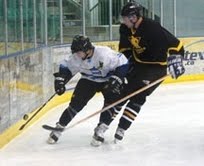Hockey is an intense cardio workout. You’re out there on the ice, sweating under pounds of heavy equipment, heart racing, eyes darting every which way, and skating like your life depends on it. It is a game of skill, speed and coordination. Above all, it is a game of heart.
Hockey as a Cardio Workout
With your arms and legs moving at varying paces throughout the game, hockey counts as High Intensity Interval Training, or HIIT – short periods of all out activity with longer periods at a moderate pace. A 170-pound man playing for the full 60 minutes can burn over 600 calories! Of course there’s more than just calorie burn at stake. With cardio, lung capacity is increased, and the heart pumps blood more efficiently. Cholesterol is reduced, risk of high blood pressure goes down, and weight-reduction leads to a decreased risk of Type 2 diabetes.
Cardio Workout to Improve Hockey Skills
To stay in hockey condition during the off-season, cardio is imperative. Rollerblading is an obvious choice to keep in skating form, but don’t discount other forms of cross-training.
- Running, biking, swimming and other steady-state workouts, in a duration of 30-60 minutes, should be interspersed with high intensity sprints to maximum heart rate.
- A slide-board is a valuable piece of cardio equipment for a hockey player, as it not only raises the heart rate, it mimics the movements of speed skating.
- Golf – walking the greens, not taking a cart – is a slower paced sport, but keeps hand-eye coordination keen. This is great for “active rest,” as heavy workouts 5 days a week require adequate recovery time.
Weight Training and Cardio
Cardio builds the heart muscle, but your other muscles need attention, too. Mix weight training in with your cardio workout. Body weight exercises require no equipment and are simple to do. These include lunges, squats, burpees, planks, pushups and triceps dips. Whenever practical, include free weights like barbells, dumbbells and kettlebells. Work muscle groups on different days, allowing adequate recovery time (approximately 48 hours) before working that group again. For example:
- chest, shoulders and arms on Monday
- back and abdominals on Wednesday
- legs and glutes on Friday
Remember the Basics
Be sure to stay hydrated, on and off the ice. Your muscles – heart included – need proper hydration to recover and remain effective. While sports drinks are fine for the all-out effort of the game, plain water is ideal for most exercises.
Pain means stop, so learn the difference between soreness (normal) and pain (not normal). Your game – and your overall health – will suffer if you push too hard through an injury.
Working with a coach or personal trainer can keep it varied. By mixing it up and having someone track your progress and challenge you, you’re sure to remain interested and motivated by your cardio workout. However, if you can’t afford to get a trainer, you can enroll in our online hockey training program which was designed by pro hockey players and coaches. Call us on 1-888-588-0554 for more details.














